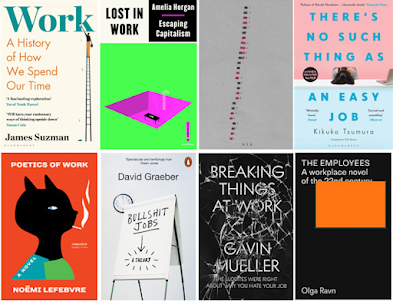| >> Read all Stella's reviews. | |
Oscar Mardell's freezing works poems are a clever addition to the tradition of New Zealand gothic literature. Think Ronald Hugh Morrison’s The Scarecrow and David Ballantyne's Sydney Bridge Upside Down and you’ll get a sense of the macabre that edges its ways through these poems like entrails. There’s the nostalgia for the stink of the slaughter yards, the adherence to the architects of such vast structures on our landscapes, and the pithy analysis of our colonial pastoral history. That smell so evocative of hot summer days cooped up in a car travelling somewhere along a straight road drifts in as you read 'Horotiu' with its direct insult to the yards and its references to offal. In these poems, there is the thrust and violence of killing alongside the almost balletic rhythm of the work — the work as described on the floor as well as the poetic structure of Mardell’s verse. “ th sticking knife th steel th saw “ the dull thud resonates Most of the poems note the architect and the date of construction for these ominous structures, which had a strange grandeur — simultaneously horrific and glorious. One of the outstanding architects was J.C.Maddison, a designer known for both his slaughterhouses and churches, alongside other stately public buildings. In 'Belfast', Mardell cleverly bridges these divides — the lambs, the worship, the elation. “ did he who set a compass There are plenty of other cultural references tucked away in these poems. Minnie Dean makes an appearance in Mataura and James K Baxter in Ngauranga Abattoir. In the latter, Mardell slips in Baxter's line "sterile whore of a thousand bureaucrats". Yet the poems go beyond nostalgia or clever nods to literature, to sharpen our gaze on our colonial relationship. 'Burnside' tells it perfectly: “ & ws new zealands little lamb Mardell’s collection, Great Works, is pithy and ironic with its clever nods to cultural and social history, gothic in imagery, and all wrapped up like a perfectly trussed lamb in our ‘God’s Own Country’ nostalgia, with a large drop of sauce and a knife waiting to slice. |
| >> Read all Thomas's reviews. | |
|
>>Genius.
>>But who has the most cats?
>>Anyone can be a hero in their own back yard.
>>Look inside the book.
>>Hungry penguins.
>>See some images/buy the book!
NEW RELEASES
>>Have a look inside!
>>We see their work, but do we know their names?
>>Making spaces and making space.
>>Have look inside!
>>Look inside.

>>Look inside!

"A wild and gratifying literary ride." —Guardian
Laing explores the capacities and vulnerabilities of the human body, and sees it as the locus of a political struggle for individual and collective freedom and authenticity. Laing uses the body as a way to consider significant and complicated figures of the past, and to understand their relevance today, when our bodies are facing both established and new threats and opportunities. Now in paperback!
>>The problems of inhabiting a body.
>>William Reich and the 'sexual revolution'.
>>An interrogation of bodies.
>>The book came out of a moment of despair.
>>Laing discusses the book with Maggie Nelson.
>>On writing the global story of liberation.
>>Finding renewal in a precision haircut.
>>Of course the book has a playlist!
>>Laing's reading piles are far from organised...
>>Other books by Olivia Laing.
The Anomaly by Hervé Le Tellier (translated by Adriana Hunter) $37
VOLUME FOCUS : Work
A selection of books from our shelves.

BOOKS @ VOLUME #300 (14.10.22)
Celebrate our 300th newsletter with a new book! Find out about the latest new books, the latest book news, and what we've been reading and recommending.
Our Book of the Week is BEST OF FRIENDS by Kamila Shamsie. This powerful new novel from the author of Home Fire contrasts the fates of two school friends whose lives are set on different tracks by an incident in their teenage years. Bridging Karachi and London, the novel unpicks the operations of power through class and gender, both in Pakistan and abroad, and explores the tensions and bonds of friendship and culture. Another subtle and insightful novel from this fine writer.
>>Read Stella's review.
>>Stella reviews the book on RNZ.
>>Thorny issues.
>>Friendship, power, and ethics.
>>Does principle or loyalty make for the better friend?
>>Why friendship?
>>What kind of democracy is this?
>>Start reading!
| >> Read all Stella's reviews. | |
|
| >> Read all Thomas's reviews. | |
|
NEW RELEASES
Click through to our website for your copies!
The Axeman's Carnival by Catherine Chidgey $35
"Herzog's writing bristles with the same eerie and uncompromising energy as his films. His jungle pulses with hallucinatory life." —Sam Byers, Guardian



Papercuts: A party game for the rude and well-read $45
>>Find out more.
VOLUME FOCUS : Fabric

Fabric: The Hidden History of the Material World
Worn: A People's History of Clothing (Reviewed for RNZ Nine to Noon)
(For VOLUME reviews of Worn, Thread Ripper, Garments Against Women and The White Dress — follow the links.)
Author of the Week:
French writer Annie Ernaux has made herself the subject of her books, and, in doing so, has written the story of everybody. In spare, precise prose, she calibrates experience against memory and the personal against the universal, and provides deep insight into experiences that few writers face so honestly and directly.
>>Ernaux has just been awarded the 2022 Nobel Prize in Literature.
>>Tuning in.
>>An introduction to the works.
| >> Read all Thomas's reviews. | |
Exteriors by Annie Ernaux (translated by Tanya Leslie) {Reviewed by THOMAS} |
| {Reviews by STELLA} | >> Read all Stella's reviews. |
First up, the local and wonderful Nicola Galloway has produced another winning title, The Homemade Table — beautifully photographed, with plenty of recipes and, as always, excellent and clear information. Fermentation, preserving, sourdough and fresh seasonal delights make this the perfect addition to your bookcase and it is sure to be a favourite for everyday recipes, pantry staples and harvesting delights. Not to be missed. Hamed Allahyari’s refugee journey from Iran was dangerous and risky. He has made Australia his home and shares his love of food at his Melbourne restaurant, SalamaTea. His first book, Salamati, is a collection of his recipes from his life as a restauranteur in Iran, his many online cooking classes, and his deep love of food and Persian culture. Food and people are at the core of his approach to cooking. “By eating my food, you come into my family. You are sitting with me, with my grandparents, parents and cousins, talking, sharing and enjoying the feeling of being together.” A wonderful introduction to this cuisine, there’s plenty of joy, inspiration and all-together deliciousness. Perfect for outdoor gatherings this season. And there’s a new Ottolenghi! The Test Kitchen is back with Extra Good Things, under the influence of the excellent Noor Murad. She’s been with the Ottolenghi crew since 2016 and brings to her cooking her Bahrani roots, alongside her interest in Arabic, Persian and Indian cuisines and flavours. As with all Ottenghi cookbooks, there’s plenty of inventive play, excellent tips and recipes which invariably offer comfort and satisfaction, flavoursome twists and exciting ingredient combinations. And working your way through this will guarantee your pantry is full of excellent additions — those extra good things — ready to make your next meal vibrant and delectable. Flexible cooking at its best. |
NEW RELEASES
>>Read Thomas's reviews of the excellent Kinsky's Grove and River.

>>Read Stella's review!
>>Read Thomas's review of parts I and II.
>>It writes itself.
| >> Read all Stella's reviews. | |
Where the Wild Ladies Are by Matsuda Aoko (translated by Polly Barton) {Reviewed by STELLA} If a ghost door-to-door salesperson called at your place, what would you do? In the opening story of Matsuda Aoko’s collection, Shinzaburō tries to ignore the doorbell. It’s persistent and there’s no getting out of answering the door. They know he’s home. His attempts at turning them away are fruitless. There they are — two women dressed identically, yet with different manners. “..the younger one,...raised her head to look towards the spyhole, and said in a weak, sinuous voice, “Come now, don’t be so inhospitable! O-pen up!” If a willow tree could speak, Shinzaburō thought, this is the kind of voice…He blinked and found himself in the living room.” And so, the story carries on, with our hapless Shinzaburō finding himself unable to resist the two women and their special lanterns. His wife is none too pleased when she returns and sees how he’s been duped by the ghost women. The story is premised by a traditional folktale of love and woe, 'The Peony Lantern'. Matsuda Aoko takes these traditional ghost stories and bends them into contemporary settings with her own sense of intrigue and humour. The short stories are variously gothic and satirical in their feminist reinterpretations. In 'Smartening Up', a young woman, obsessed with her body hair, is visited by her interfering dead aunt, an aunt who has definite opinions about an ex-boyfriend, and money wasted on beauticians and clothes. Mostly though she’s concerned — the young woman is destroying the power of her hair! After a bit of a tussle, the two women settle into a discussion about the aunt’s suicide and a housewife’s lot. It’s a conversation that entwines the legend of Kiyohime and ultimately, triggers a programme of hair restoration for our young heroine. “Let’s become monsters together.” Some ghosts just want to be recognised. 'Quite A Catch' dredges up a ghost from the depths, a beautiful woman who long ago in the past was murdered finds a willing partner in Shigemi who fishes her skeleton from the lake. Haunting, it’s an observant eye on expectation and loneliness. The rakugo (a Japanese form of verbal storytelling) Tenjinyama is the inspiration for the tale 'A Fox’s Life', the story of a striking unusual woman. Brilliant, at school she excels in all her subjects and in sports, always finding a shortcut to problems, finding beautiful solutions with little effort, yet she has no desire to take her learning to the next level. At work, this was no different: everything comes easily to her, but she eschews success. She marries a kind-hearted man, stays home, has children, who grow and leave home. Something remains buried within her — a reticence to fully engage all her skills. “Throughout her life, Kuzuha had always had the feeling that she was just pretending to be a regular woman. Of course, that was the path she had selected as a shortcut, and she had never once doubted her decision had been the right one…one day…it occurred to Kazuha that maybe she really was a fox.” Each story in the collection recounts a woman’s life and her place within contemporary Japanese society with links to folktales of love, woe, revenge and mystery. Running throughout the book is another thread — a fascinating twist which draws some of these stories and characters together. It’s a thread that concerns a factory, populated by both a ghost and living human workforce, producing magical or special items which find their way into the world of the living. What these items represent is never fully articulated, but the idea of this place is intriguing and it seems to represent a bridge between the two worlds of the living and dead — each fascinated by the other. |






































































.jpg)

